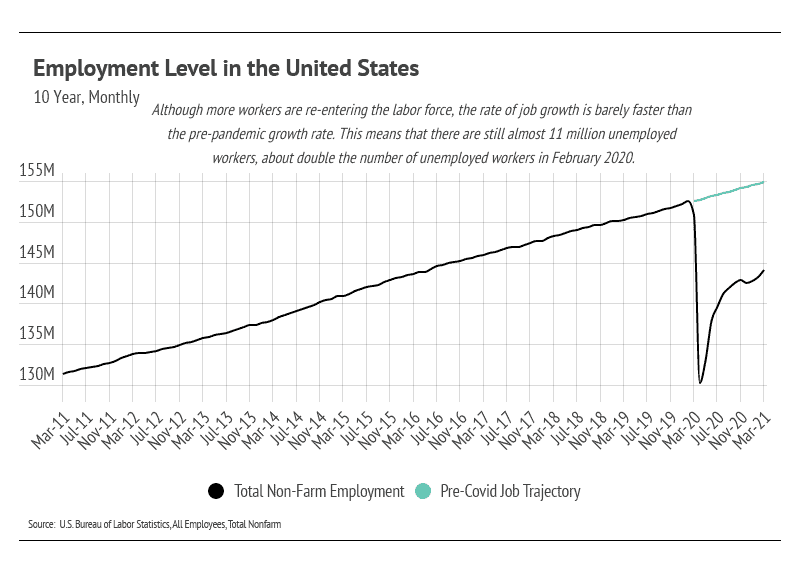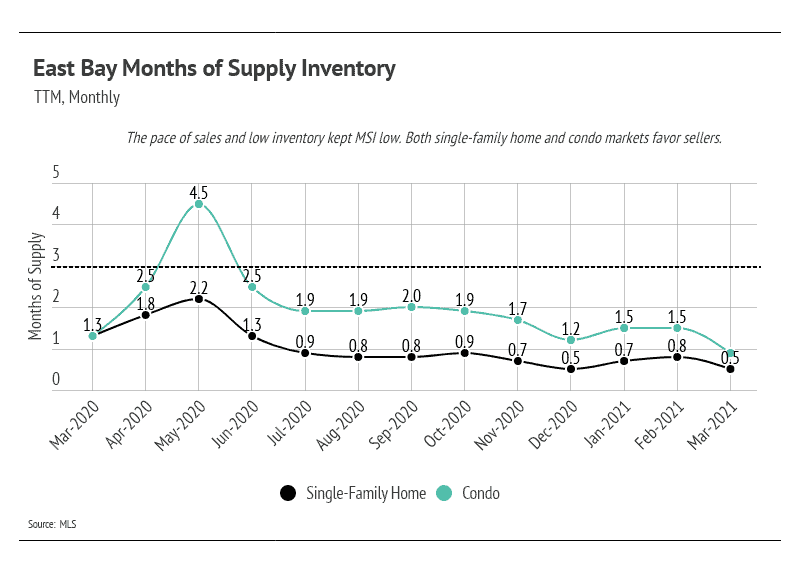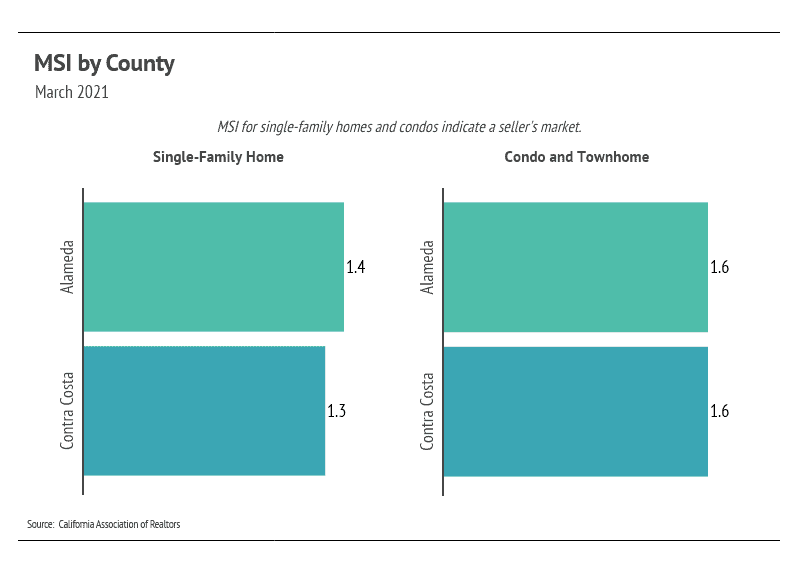May 2021 East Bay Market News
Real Estate

Real Estate

Welcome to our May newsletter, where we dive into national and local residential real estate trends. This month, we examine how the housing undersupply is increasing home prices and paving the way toward a more balanced market. We also discuss the sharp decrease in mortgage rates and the state of employment, which is historically one of the leading indicators of home valuations.
Currently, the housing supply is so low that demand far outpaces the number of homes on the market. Freddie Mac estimates that the United States is about 4 million homes short of meeting buyer demand. The housing shortage compounds when potential home sellers decide to stay out of the market because they feel they won’t be able to find a home to buy after they sell. Home builders, who have been slow to ramp up production after the 2008 crash, are drastically increasing new construction because they want to capitalize on the sustained demand for housing.
We expect relative housing demand to remain high over the next 12 months at the very least. New homes take time to build and will not come to market at the rate necessary to balance it. In March 2021, U.S. home builders started constructing homes at a seasonally adjusted annual rate of 1.74 million, up 37% compared to March 2020. New construction will eventually alleviate some of the shortage, but housing will remain undersupplied for months, if not years, to come.
As we navigate this period of high buyer demand and low supply, we remain committed to providing you with the most current market information so you feel supported and informed in your buying and selling decisions.
In this month’s newsletter, we cover the following:
Last year, many individuals and families experienced feast or famine. Those lucky enough to stay financially unaffected by the pandemic were likely saving or investing more than expected, accruing more and more capital. At the same time, interest rates plummeted to hyperlow levels as millennials, the largest living adult generation, grew to prime homeownership age. With these factors combined, we saw the demand for homes skyrocket in 2020. The near-universal ability to work remotely changed motivations for moving. Relocating for a job or to be closer to the office was no longer necessary. However, due to the unique requirements of working from home, people began wanting more space. As a result, single-family home demand rose steeply, while condo demand lagged. As sellers listed condos, they bought single-family homes, driving single-family home inventory down. As the supply of homes declined, fewer new listings came to market—in part, because of the difficulty of finding a new home after selling.
One reason for the housing shortage has been the understandable hesitancy of builders to construct new properties since the 2006–2008 housing crash; however, this lack of new construction means that there aren’t enough homes on the market to meet the unexpectedly high demand. Over the last six months, new construction has ramped up considerably to an annualized 1.74 million new homes. The largest gains in new-home construction occurred in the Midwest, where housing starts more than doubled on a monthly basis. The Northeast and the South also saw faster rates of new-home construction, while home-building activity slowed in the West. Additionally, established metro areas lack land upon which to build, so adding meaningfully to supply through new construction can be challenging or fully unattainable.
As you can see from the chart below, new construction is now in the pre-housing bubble levels as home builders react to the surge in home prices and demand.

Mortgage rates rose significantly, slightly over 50 basis points, from January 2021 to mid-April 2021, but dropped sharply back below 3% in the second half of April. Although interest rates are still expected to rise to 3.7% over the course of the year, according to the Mortgage Bankers Association, the mortgage rate drop shows the non-linear path that rates will likely take. Because the mortgage rate affects affordability, the current low rate will only increase demand in the short term.

High unemployment is one of the strongest predictors of falling home prices over a two-year period. The chart below illustrates the employment cost of a recession. Total employment tends to grow at a fairly consistent rate during economic expansions. The green line illustrates the expected level of employment had the pandemic never happened. As that green line shows, we are nearly 11 million jobs below where employment was expected to be after the first quarter of 2021. Twice as many workers are currently unemployed than in February 2020. The initial pain of unemployment has been dampened by government relief. Mortgages in forbearance and foreclosures are low, as are delinquencies in credit card debt. However, we will continue to monitor unemployment in order to gauge future market conditions.

Although we don’t expect the same level of buying in 2021 that we saw in 2020, the environment is right for demand to outpace supply in 2021. In the short term, we may even see a demand spike as potential buyers try to purchase before rates rise higher. As a result, we anticipate a competitive landscape for buyers over the course of this year.
While the market remains competitive for buyers, conditions are making it an exceptional time for homeowners to sell. Low inventory means multiple offers and fewer concessions. Because sellers are often selling one home and buying another, it is essential that sellers work with the right agent to ensure the transition goes smoothly.
During March 2021 in the East Bay, median single-family home prices rose to new all-time highs in Alameda and Contra Costa. Year-over-year, home prices increased considerably, up 20% in Alameda and 29% in Contra Costa.


As you can see in the graph below, median condo prices were up across counties. Contra Costa condos showed large price gains.

Single-family home inventory began to climb over the last two months in anticipation of the spring season, when more sellers typically come to market. In 2020, fewer people wanted to leave the East Bay and more people wanted to move to the area, which drove inventory down to record low levels. New listings, therefore, improve the current market conditions. In March 2021, the East Bay inventory was slightly below last year’s level. The sustained low inventory will likely cause prices to appreciate throughout 2021.

Like the number of single-family homes, the number of condos on the market rose in March, but inventory levels remain far higher than last year, with 31% more condos available.

Both single-family homes and condos spent less time on the market in March 2021 than they did last year. As we will see, the pace of sales has contributed to the low Months of Supply Inventory (MSI) over the past several months.

Both single-family homes and condos spent less time on the market in March 2021 than they did last year. As we will see, the pace of sales has contributed to the low Months of Supply Inventory (MSI) over the past several months.

We can use MSI as a metric to judge whether the market favors buyers or sellers. The average MSI is three months in California (far lower than the national average of six months), which indicates a balanced market. An MSI lower than three means that there are more buyers than sellers on the market (that is, it is a sellers’ market), while a higher MSI means there are more sellers than buyers (that is, it is a buyers’ market). In March 2021, the MSI fell below one month of supply for single-family homes and remained at one month of supply for condos, indicating that the market strongly favors sellers.


In summary, the high demand and low supply present in the East Bay have driven home price appreciation. Inventory will likely remain low this year with fewer sellers coming to market, potentially lifting prices higher. Overall, the housing market has shown its resilience through the pandemic and remains one of the most valuable asset classes. The data show that housing has remained consistently strong throughout this period.
We anticipate new listings to accelerate into the summer months. The current market conditions could withstand a high number of new listings coming to market, and more sellers could enter the market to capitalize on the high buyer demand. As we enter the spring season, we expect the high demand to continue, and new houses on the market to be sold quickly.
As always, we remain committed to helping our clients achieve their current and future real estate goals. Our team of experienced professionals are happy to discuss the information we’ve shared in this newsletter. We welcome you to contact us with any questions about the current market or to request an evaluation of your home or condo.
Interested in a monthly market update? Subscribe here!
Stay up to date on the latest real estate trends.

Quick Take: Mortgage rates rose in February, closing the month at 6.94%. However, the Fed will almost certainly cut rates at some point this year, so potential homebu… Read more

Quick Take: Mortgage rates rose in February, closing the month at 6.94%. However, the Fed will almost certainly cut rates at some point this year, so potential homeb… Read more

Quick Take: After the average 30-year mortgage rate fell over 1% in November and December 2023, rates stabilized between 6.60% and 6.70% in January 2024. Median price… Read more

Quick Take: After the average 30-year mortgage rate fell over 1% in November and December 2023, rates stabilized between 6.60% and 6.70% in January 2024. Median pric… Read more

Quick Take: The average 30-year mortgage rate fell 1.18% in the last two months of 2023, which is a significant drop from the 23-year high reached at the end of Octob… Read more

Quick Take: The average 30-year mortgage rate fell 1.18% in the last two months of 2023, which is a significant drop from the 23-year high reached at the end of Octo… Read more

Quick Take: The Fed telegraphed that rate hikes are ending, and financial markets expect rate cuts in 2024, which will meaningfully reduce the cost of financing and i… Read more

Quick Take: The Fed telegraphed that rate hikes are ending, and financial markets expect rate cuts in 2024, which will meaningfully reduce the cost of financing and … Read more

Quick Take: The national median home price declined 3.8% in the third quarter, landing only 4.7% below the all-time high reached in June 2022 and reflecting typical se… Read more
Any questions at all, happy to help!